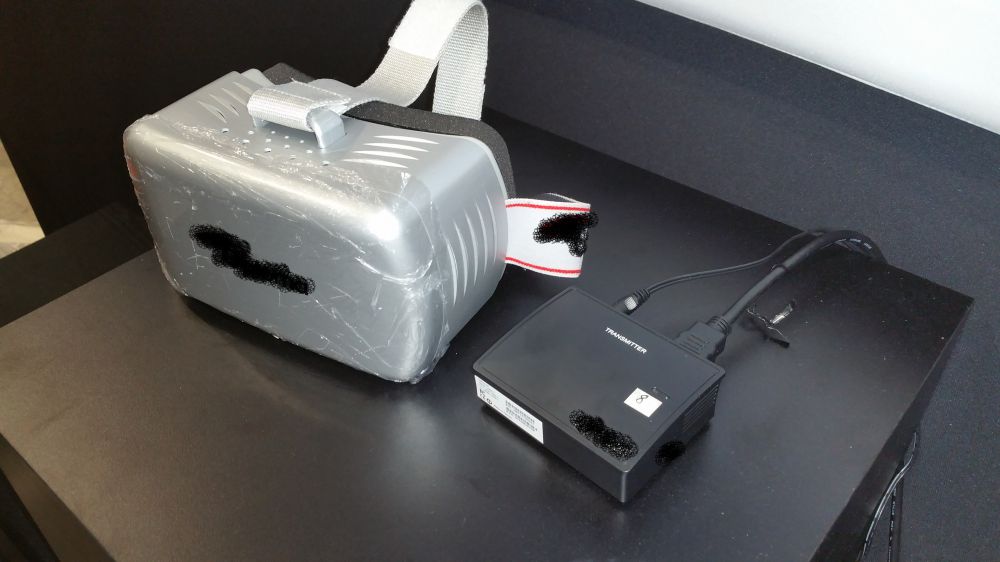Untethered PC-Connected VR Might Come Sooner Than You Think (Updated)
Update March 10, 12:08pm PT: More details have emerged about the wireless VR HMD, including the company behind it. The Immersive Technology Alliance announced today that Optoma, a projection technology company, is the entity behind the wireless VR headset. The company revealed that the HMD will communicate via a proprietary 2.4 GHz signal. The ITA said that prototype devices are "being hand made as we speak," and it is hoping to host a tech demo at the next annual ITA meeting.
The ITA also announced that Optoma has joined the Immersive Technology Alliance as it's newest member.
Original article:
There’s a new VR HMD being developed that will work on your PC without wires tethering you down. The brand name isn’t being revealed, but MTBS3D was given access to an early prototype and was given permission to share some of the details.
Neil Schneider, President and CEO of Meant To Be Seen (MTBS3D) and Founder of The Immersive Technology Alliance, shared some interesting and exciting news today about a new VR HMD that is being developed by a “reputable brand” that “has been around for many years.”
Many of the details regarding the new VR HMD, including the brand behind it, the name of the device, and what method the wireless head and body tracking will use, are being withheld for now, but MTBS3D was given permission to reveal some of the hardware specifications. However, MTBS3D noted that much of it is subject to change as the development of the product advances.
The display in the headset is a 5.46-inch color AMOLED Full-HD display with a 120 Hz refresh rate. The headset also features independent adjustable eye relief and it has a 3-lens optical module and offers a 90 degree FOV. MTBS3D indicated that the current field of view is for the prototype, so it could be wider in later revisions.
Get Tom's Hardware's best news and in-depth reviews, straight to your inbox.
The real interesting part of this announcement is of course the wireless capabilities of the HMD. The current prototype apparently includes a wireless video receiver embedded in the HMD. MTBS3D said the HMD is currently limited to a 15- to 20-foot range, which is limited only by the amount of power the receiver is allotted. The current power source is a 16,000 mAh battery pack that is connected via USB 2.0.
The transmitter that sends the video signal connects to the PC with an HDMI cable, and it requires external power to function.
MTBS3D was not given permission to share the name of the company making the wireless HMD, but it was able to share some images of the hardware. We’ve been told the headset is not being built by Razer, but the shell of the HMD appears to be a carbon copy of the current OSVR Hacker Developer kits.
Follow Kevin Carbotte @pumcypuhoy. Follow us on Facebook, Google+, RSS, Twitter and YouTube
Kevin Carbotte is a contributing writer for Tom's Hardware who primarily covers VR and AR hardware. He has been writing for us for more than four years.
-
quilciri I guess the more, the merrier, but I can't help but feel a third party wireless solution compatible with the Vive and Occulus might have been easier to develop and more profitable. I'd me more than willing to strap a battery/receiver pack to my belt with a short cord to the headset rather than the tethers we currently have.Reply
I don't know the design hurdles for that, though. -
falchard Main limitations are probably bandwidth and patency. Need an absurd amount of bandwidth for vr quality video. Do they use like 10 transmitters on different frequencies.Reply -
quilciri The Vive can connect over HDMI, which has a theoretical max bandwith of 10.2 Gb/s.Reply
Wireless AC isn't far off that at 7Gb/s (using all 8 channels). Given that you'll be very near and in line of sight of the transmitter at all times, we should be able to get close to that.
I know data transfer from the headset to the PC will eat a big chunk of that, but you could actually use two separate wireless networks operating in different frequencies for data to/from the PC.
*there was a 100 Gb/s wireless network successfully demonstrated two years ago, though
http://www.extremetech.com/electronics/168566-worlds-fastest-wireless-network-hits-100-gigabits-per-second-can-scale-to-terabits -
dstarr3 While I would like this, I still have to say, I'll believe it when I see it. I feel like bandwidth and latency are going to ENORMOUS hurdles to get over. That's so much data to transmit wirelessly.Reply
Things like Steam's in-home streaming admittedly work pretty well, if you're viewing it on a TV on the other side of the living room. If you put that screen a couple inches from your eyes, the compression artifacts would become VERY obvious and distracting. Not to mention the input lag. If your display is lagging so many milliseconds behind your head movements, you are going to get so motion sick so fast.
Again, it'd be great to see it happen and working well. But... that's a tall order. -
hellwig I bought an HDMI wireless transceiver. It just uses 802.11N (5GHz) and creates a private wifi network. I imagine an 802.11ac network could suffice, with the base station having very high power to transmit the video signals, with the headset needing far less power to simply relay telemetry back to the the PC. Heck, basic controls could be Bluetooth, with the wifi being essentially one-way for video.Reply
-
jaber2 So, current version would be 1.0, the ver 2.0 would be wireless? the more I read the more I want to stay away until ver 3.0Reply -
e36_Jeff wireless VR is the usage that 802.11ad is begging for. Tons of bandwidth, but needs line of sight to work well.Reply

